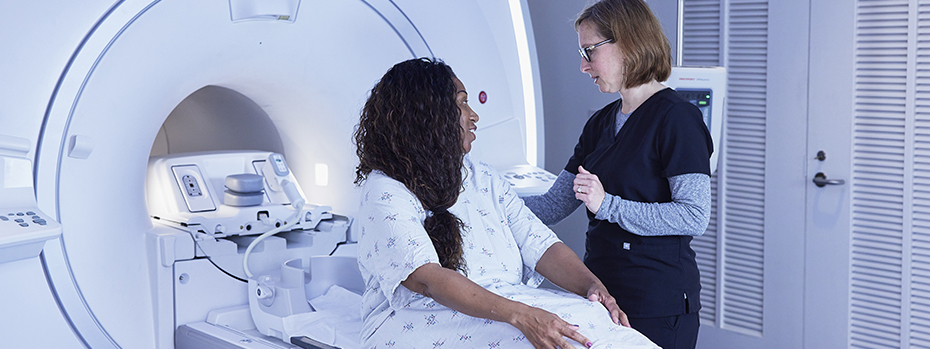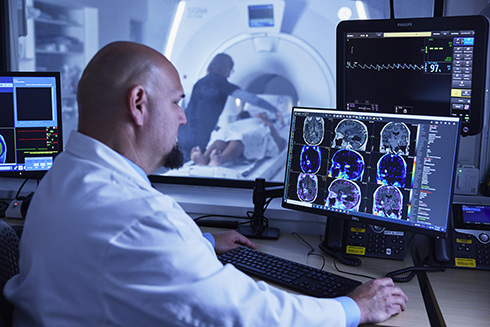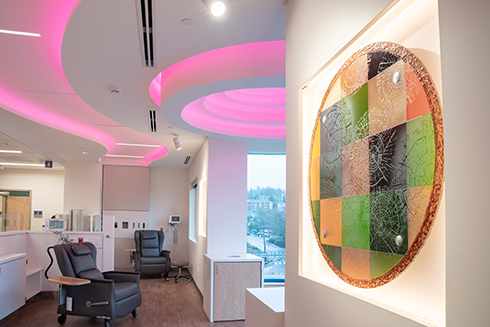Nuclear Medicine

Nuclear medicine uses tiny amounts of radioactive material for precise and painless diagnosis and treatment. Nuclear medicine is also called molecular imaging and therapy.
We’ve provided nuclear medicine since the 1960s, when we began offering radioactive iodine therapy. Today we offer:
- The only PET/MRI scanner in Oregon
- State-of-the-art technology
- Radiologists who specialize in reading nuclear medicine scans and using them to help plan treatment
- A team of medical physicists who help provide advanced treatments that aren’t widely available
- Expertise in theranostics, a type of care that tailors imaging and treatment to you
We see patients of all ages.
Understanding nuclear medicine

What it’s used for
Your doctor may recommend nuclear medicine to diagnose or treat:
How it works
We place a bit of radioactive material inside your body. We may call this material a tracer, isotope or radiopharmaceutical. It gives off radiation that we use to create images or use in treatment.
With theranostics, we create a custom care plan that combines diagnosis and treatment. We use a tracer to see which cells in your body need treatment. Then we use a therapy tracer to target those cells.
Nuclear medicine for diagnosis
Before your appointment
You’ll get instructions from our staff and through MyChart. Please follow them, or we may have to reschedule your scan. If you have questions, please call us at 503-494-8468.
Please let us know if you are:
- Pregnant or think you may be pregnant
- Not able to lie still longer than a few minutes
In some cases, you may get your tracer a few hours or days before your scan. You’ll most likely get it by IV. Tracers can also be inhaled or swallowed as a pill or liquid.
If you’re anxious about being in our scanner, you can ask your doctor to prescribe medication to help you relax. In that case, please bring someone to drive you home.

At your appointment
You’ll be asked to take off any items, including jewelry, that may disrupt the scan. If you need to take off clothing, you’ll get a gown.
You’ll get your tracer, if you haven’t already.
You’ll lie down on a table that moves in and out of the tunnel-shaped scanner. We have cushions for comfort.
In some cases, you may have multiple scans over several hours or days. If you are having scans over several days, you can go home in between.
After your appointment
Drink more water than usual for 24 to 48 hours to help flush the tracer from your body. Most tracers leave your body within a day. When you have nuclear medicine for diagnosis, you do not need to avoid other people afterward.
If you had an IV, let us know about any pain, redness or swelling where it was placed.
You’ll usually get results through MyChart within 24 to 48 hours.
Nuclear medicine for treatment
Before your treatment
We’ll schedule an in-person or virtual visit with a doctor to discuss your treatment plan. When you have nuclear medicine for treatment, you’ll get instructions for keeping others safe from the radiation you’ll have.
During your treatment
Your treatment is designed for you. How long your treatment takes and how much radiation you get will vary.
After your treatment
You’ll usually get results through MyChart within 24 to 48 hours.
Frequently asked questions about nuclear medicine
Do you use contrast dye for nuclear medicine?
No. We use radioactive tracers, which are not dyes or medications.
Does nuclear medicine have any side effects?
It depends.
If you have nuclear medicine to help with a diagnosis, you won’t feel pain or have other symptoms.
If you have nuclear medicine for treatment, you may have side effects. We will discuss those with you before treatment.
What are your hours?
We provide imaging and treatment between 8 a.m. and 5:30 p.m. weekdays.
For patients
You’ll need a doctor’s referral to make an appointment.
Questions: 503-494-8468
Locations
Molecular Imaging and Therapy Clinic, Marquam Hill
Mark O. Hatfield Research Center, 14th floor
3250 S.W. Sam Jackson Park Road
Portland, OR 97239
OHSU PET/CT Imaging Clinic, Marquam Hill
Peter O. Kohler Pavilion, fourth floor
808 S.W. Campus Drive
Portland, OR 97239
OHSU Diagnostic Imaging Clinic, South Waterfront
Center for Health and Healing, Building 1, third floor
3303 S. Bond Ave.
Portland, OR 97239
OHSU Diagnostic Imaging Clinic, Beaverton
15700 S.W. Greystone Court
Beaverton, OR 97006
PET/MRI only
Lamfrom Biomedical Research Building
3215 S.W. Pavilion Loop
Portland, OR 97239
Free parking for patients and visitors
Refer a patient
- Refer your patient to OHSU.
- Order diagnostic imaging.
- Call 503-494-4567 to seek provider-to-provider advice.
- Share your imaging.